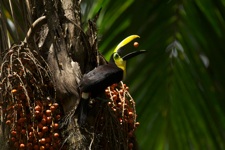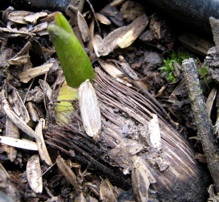 Pollen and seed dispersal are key reproductive processes in plants, and they often rely on dynamic, mutualistic relationships with animal dispersal agents. Through their dispersal services, these animals shape patterns of genetic diversity and variation in plant communities. Our lab provides insights into how and why different animals vary in the dispersal services they provide, and what the consequences are for plant species and communities on local and regional scales. These questions are of fundamental importance for evolutionary ecologists, and also have important conservation consequences, since better understanding these relationships will help predict how global change may upset these mutualisms.
Pollen and seed dispersal are key reproductive processes in plants, and they often rely on dynamic, mutualistic relationships with animal dispersal agents. Through their dispersal services, these animals shape patterns of genetic diversity and variation in plant communities. Our lab provides insights into how and why different animals vary in the dispersal services they provide, and what the consequences are for plant species and communities on local and regional scales. These questions are of fundamental importance for evolutionary ecologists, and also have important conservation consequences, since better understanding these relationships will help predict how global change may upset these mutualisms.
One line of research combines genetic analyses of naturally dispersed pollen and seeds, animal tracking, and field-based observation and experimentation in the Chocó rainforests of northwest Ecuador. Here, we have generated a longitudinal data set of molecular and field data, with a particular focus the dispersal of the canopy palm tree Oenocarpus bataua by dispersal agents including toucans and long-wattled umbrellabirds. Dr. Luke Browne, a lab alum, provided correlational and experimental evidence that genetic rarity of a dispersed seedling has a major impact on survival, and revealed how seed vs. pollen flow interact to shape patterns of genetic structure in continuous and fragmented habitats. Current PhD candidate Zoe Diaz-Martin is investigating similar questions at a landscape scale, across Ecuador. And Ph.D student Kaushik Narasimhan is expanding animal tracking and camera trapping efforts to quantify seed dispersal patterns by different dispersal vectors in a range of habitat types.
We have also explored interactions between dispersal agents and plants in a range of other systems. Dr. Jenny Hazlehurst, a lab alum, evaluated how foraging ecology of hummingbirds is affected by nectar robbery in Peru and southern Ecuador, and we have investigated how spider monkey dispersal shapes palm tree genetic structure in the Amazon.
Related Publications
2017
Walter, S.T., L. Browne, J. Freile, J. Olivo, M. Gonzalez, and J. Karubian. 2017. Surrounding tree cover predicts diversity of large-bodied frugivorous birds in forest fragments. Biotropica. in press.
2017
Hazlehurst, J.A., B. Tinoco, S. Cardenas, and J. Karubian. 2016. Pollination Ecology of Oreocallis grandiflora (Proteaceae) at the northern and southern ends of its geographic range. Journal of Pollination Ecology, 19: 71-80. PDF
2016
Browne, L. and J. Karubian. 2016. Negative frequency-dependent selection for rare genotypes promotes genetic diversity of a tropical palm. Ecology Letters. 19: 1439-1447 PDF
2016
Hazlehurst, J.A. and J. Karubian. 2016. Nectar robbing impacts pollinator behavior but not plant reproduction. Oikos. doi 10.1111/oik.03195. PDF
2016
Browne, L. and J. Karubian. 2016. Diversity of palm communities at different spatial scales in a recently fragmented tropical landscape. Botanical Journal of the Linnean Society. 182: 451-464. PDF
2016
Karubian, J., L. Browne, D. Cabrera, M. Chambers, and J. Olivo. 2016. Relative influence of relatedness, conspecific density, and microhabitat on seedling survival and growth of an animal-dispersed Neotropical palm, Oenocarpus bataua. Botanical Journal of the Linnean Society 182: 425-438. PDF
2015
Browne, L., K. Ottewell, and J. Karubian. 2015. Short-term genetic consequences of habitat loss and fragmentation for the neotropical palm Oenocarpus bataua. Heredity. doi: 10.1038/hdy.2015.35. PDF
2014
Karubian, J. and R. Durães. Impacts of mating behavior on plant-animal seed dispersal mutualisms: a case study from a Neotropical lek-breeding bird. In Sexual Selection: Insights from the Neotropics (eds. R. Macedo and G. Machado). Elsivier Press. Pp. 365-390. PDF
2013
Karubian, J. 2013. Award for Excellence in Tropical Biology and Conservation. Biotropica 45(6) 772-773. PDF | Web
2013
Kraul, C. 2013. Ecology in Action. Tulanian Magazine. PDF – News piece on work in Ecuador
2012
Scofield, D.G., P.E. Smouse, J. Karubian and V.L. Sork. 2012. Using alpha, beta, and gamma diversity to characterize seed dispersal by animals: social behavior matters. American Naturalist. PDF
2012
Karubian, J., L. Browne, C. Bosque, T. Carlo, M. Galetti, B.A. Loiselle, J.G. Blake, D. Cabrera, R. Durães, F.M. Labecca, K.M. Holbrook, R. Holland, W. Jetz, F. Kummeth, J. Olivo, K. Ottewell, G. Papadakis, G. Rivas, S. Steiger, B. Voirin, and M. Wikelski. 2012. Seed dispersal by Neotropical birds: emerging patterns and underlying processes. Neotropical Ornithology. PDF
2012
Ottewell, K., E. Grey, F. Castillo, and J. Karubian. 2012. Direct parentage analysis reveals non-leptokurtic pollen dispersal in the insect-pollinated tropical palm Oenocarpus bataua. Heredity. doi: 10.1038/hdy.2012.40 PDF | Commentary | Podcast
2012
Karubian, J., R. Durães, J. Storey, and T.B. Smith. 2012. Mating behavior drives seed dispersal in the long-wattled umbrellabird Cephalopterus penduliger. Biotropica 44: 689-698. PDF *Recipient: 2013 Award for Excellence in Tropical Biology & Conservation
2011
Karubian, J. 2011. The Long-wattled Umbrellabid: the feathered gardeners of the Choco. Terra Incognita 72: 8-18. (July 2011) PDF
2010
Karubian, J., V.L. Sork, T. Roorda, R. Durães, and T.B. Smith. 2010. Destination-based dispersal by the long-wattled umbrellabird Cephalopterus penduliger homogenizes genetic structure of a tropical palm. Molecular Ecology 19: 1745-1753. PDF | Cover Page
2010
Karubian, J. 2010. Pompadours in the palms. Natural History Magazine. 119: 28-32. (February 2010) PDF
2009
Karubian, J. 2009. The secret life of the Long-wattled Umbrellabird. El Commercio Newspaper, Ecuador (May 10, 2009) PDF
2009
Karubian, J. and R. Durães. 2009. Effects of seed disperser social behavior on patterns of seed movement and deposition Oecologia Brasiliensis 13(1): 45-57. PDF


